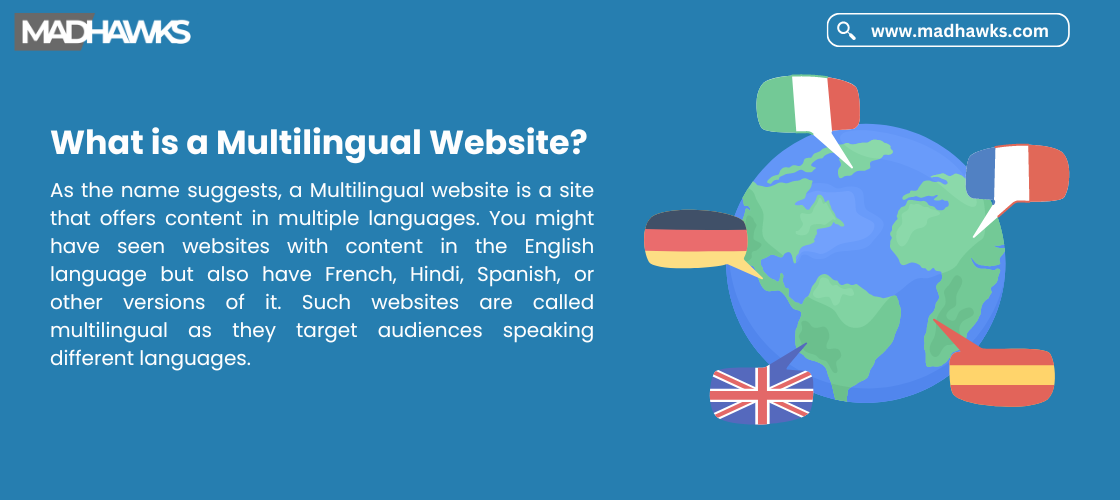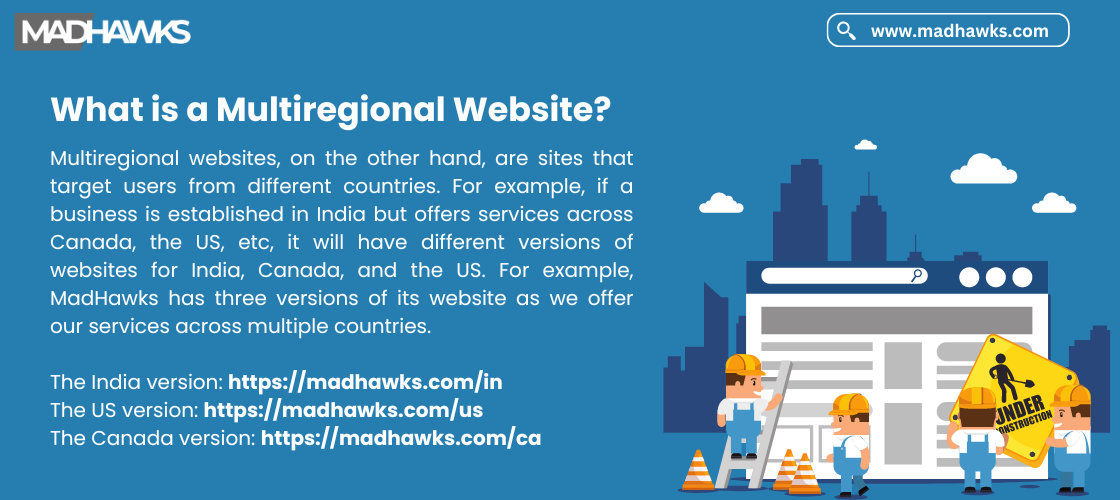Managing Multilingual and Multiregional Websites: SEO Strategies to Drive Success
Posted By Gaurav | 08-May-2024 | Search Engine OptimizationAs per Google, over 90% of new internet users prefer accessing information in their native language. Considering this, do you think your website is suitable for all the segments of the population that you want to target? If not, you need to understand the concept of multilingual and multiregional websites.

There are several challenges involved in managing a single website perfectly. Imagine how it would be to manage multiple websites at the same time. If you are offering your business services across multiple countries or locations, but have only a single version of your website, you are probably missing out on a large set of audience. But that doesn’t mean you need an entirely different domain for each location or each language you target. This is where the concept of multilingual and multiregional websites comes into play.
These are websites having different location-specific or language-specific versions. Although multilingual and multiregional websites are two different things, the involved strategies often overlap. But in order to manage such websites, you must have a clear understanding of what multilingual and multiregional websites are and what are the best strategies to manage them:
What is a Multilingual Website?

As the name suggests, a Multilingual website is a site that offers content in multiple languages. You might have seen websites with content in the English language but also have French, Hindi, Spanish, or other versions of it. Such websites are called multilingual as they target audiences speaking different languages.
What is a Multiregional Website?

Multiregional websites, on the other hand, are sites that target users from different countries. For example, if a business is established in India but offers services across Canada, the US, etc, it will have different versions of websites for India, Canada, and the US. For example, MadHawks has three versions of its website as we offer our services across multiple countries.
- The India version: https://madhawks.com/in
- The US version: https://madhawks.com/us
- The Canada version: https://madhawks.com/ca
Understanding the Basics of Multilingual and Multiregional SEO
Now that you are aware of the difference between multilingual and multiregional websites, let us move further in the topic and understand how multilingual SEO differs from multiregional SEO.
A multiregional SEO strategy involves tactics that the website publishers use to rank the website across multiple geographies. This strategy is suitable for businesses that offer products/services globally or for websites that target a global audience.
On the other hand, a multilingual SEO strategy is all about optimizing a website’s content in different languages to appear in the SERPs for each involved language. With this, the goal is to make a website’s content relevant for different language speakers.
Importance of a Multilingual Website
Google says that more than 90% of new internet users prefer to access content in their native language. Not only this, but a study has also shown that around 68% of consumers are highly likely to switch to a brand that supports their native language. This data itself is enough to show how impactful it can be to have a multilingual website. Even though you are publishing content in a widely known language, you might be missing out on a large amount of traffic just because you don’t have different linguistic versions of your site.
Difference Between Multiregional and Multilingual SEO
People often use the terms ‘multiregional SEO’ and ‘multilingual SEO’ interchangeably. However, there is a significant difference between the two.
In a multilingual SEO strategy, you might be optimizing your website for languages-specific users across multiple countries, your own country, or just within your state. The distribution curve can largely vary depending on what is your audience size. For example, if you want to target the entire South Indian population, you can create different versions of your websites for different language speakers. For this, you will need a Tamil version, a Malayalam version, a Kannada version, and an English version.
On the other hand, multiregional SEO involves optimizing your website for different but wider segments of audiences. Language is not always a barrier in multiregional SEO. A business might be offering its services across multiple countries speaking the same language. However, that doesn’t mean the content of all its versions would be the same. Optimization of different versions is done by using the local jargon of that particular region, giving cultural references, etc.
Managing SEO for Multilingual and Multilingual Websites
If you have decided to move forward with multilingual or multiregional websites, you must be aware of the best practices to manage the SEO of these sites. Let us help you with the same.
1. URL Structure
Once you have all the geographies and languages you are going to target, the first step you need to take is to finalize the URL structure for each version. One common issue that multiregional and multilingual websites tend to face is the duplicacy of content, which leads to lowered search engine rankings. To avoid this, you can follow any of the following methods to set up URL structures for your website:
- ccTLD (Country Code Top Level Domain): These are the domains with generic extensions replaced by specific country codes. Put in simple words, these domains do not have generic extensions, such as .com, .org, .net, etc, but instead specific registered country codes, such as .ca, .uk, .in, .de, .bz, .la, etc. For example, a website with ccTLD in United Kingdoms will look like ‘xyz.uk’ instead of ‘xyz.com.’
- Generic Top Level Domain (gTLD) combined with subdomain: These domains have generic domains (such as .com or .net) as well as location-specific subdomains. A site using this method to create a URL structure will something like this: ‘uk.xyz.com’
- Subdirectory with gTLD: In this, a generic Top Level Domain (such as .com, .org, .net, etc) is used but different versions of the same website are created by creating subdirectories for different locations. A website using this method will look something like this: ‘xyz.com/uk’. The examples of different versions of the MadHawks website that we gave earlier in this article are made using this method only.
2. Sitemap
If you are using a multilingual website, make sure that your website has a proper sitemap that contains the different language versions. Also, it is important to submit this sitemap to Google Search Console. This helps search engines better understand your website’s content and display the relevant versions of your website to the users.
3. HTML Content
When creating content for different versions of your website, make sure that the meta tags, titles, headings, etc, are also adjusted accordingly. You can use localized meta tags and language-specific keywords or phrases in your content to ensure that it is displayed to the right set of audience.
4. Proper Translation
This is one of the most important things to keep in mind if you are planning to have a multilingual website. You can either use a translation that translates every piece of content for each involved language or you can just create different content pieces for every version of your website.
When using a translation tool, there is a risk of compromising the quality of content as the meaning of sentences often gets lost in translation. Therefore, creating original content for each version is a better approach. However, if you want the same content to be accessible to different language-speakers, what you can do is to use default translation, but get the content reviewed and edited before publishing.
5. Optimizing for Global SEO Rankings
Optimizing your website in even just one language or for one region is challenging. And when you are managing a multilingual or multiregional website, it becomes even more difficult. You have to pay attention to the SEO of each version in order to ensure that search engines are able to see and display all of them. Here are some additional SEO tips for multiregional and multilingual websites:
- Make sure that the content is properly translated for multilingual websites. It should not lose its original value and meaning.
- The URLs should be structured properly so that search engines can display your websites to relevant audiences.
- Use hreflang tags to let search engines know that there are different versions of your site.
- Look for long-tail keywords in different languages to improve your site’s visibility for more specific search queries.
Ensure the Best SEO for Your Multilingual or Multilingual Website with MadHawks
When managing a multiregional or multilingual website, you have to keep numerous factors in mind and ensure that each version of your site is properly optimized for the respective target audience. MadHawks, being the top SEO agency, can help you achieve your goals with such websites. With good experience and expertise in offering multiregional and multilingual SEO services, our team of SEO professionals has the proper knowledge of techniques and strategies to make a website successful. For any further information on this, contact us today!
FAQs
1. What is the difference between multilingual and multiregional?
Ans. Multilingual websites have different language-specific versions, whereas multiregional websites has different location-specific versions.
2. What is a multilingual website URL structure?
Ans. A multilingual website’s URL structure is a combination of gTLD and a subdirectory for different languages. For example, a site ‘xyz.com/fr’ has gLTD (.com) and subdirectory (/fr), targeting french speakers.
3. What is the advantage of a multi-language website?
Ans. A multi-language website is relevant for different language-speakers. If you want to target users from different geographies, who speak different languages, having a multilingual website is the best approach to make your content visible and understandable to all of them.
4. What is the best way to make a multilingual website?
Ans. The best way to make a multilingual site is to use a URL structure having a gLTD and subdirectories for different languages. You can either use a default translator to translate the content of each page and display it to audiences or you can separately create content for each language-specific version.
5. Why multilingual SEO?
Ans. Multilingual SEO helps improve your website’s visibility in SERPs and expand your brand’s reach to a greater extent.

